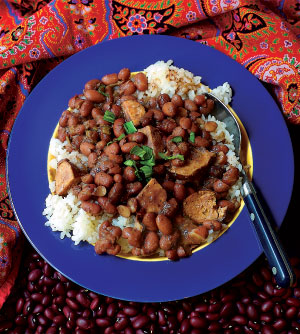
Slow Food
By Candy Sagon
Start the cooker when you leave for the day, or set it to run when you're asleep at night and enjoy tasty, nutritious meals. Better yet, get your guys to give it a go.
You open the door at the end of a hectic day, and the house is filled with a mouth-watering aroma that means dinner is served. Or you come downstairs for breakfast, and dinner already has been cooked, ready to be refrigerated until you heat it up that night. Is it any wonder why the slow cooker is so popular with busy families?
 The slow cooker — you may know it as the Crock-Pot — is basically an electric pot with an insulated insert that allows food to cook at a consistent, low temperature for as long as 12 hours. Simple to use, it’s the perfect solution for busy evenings filled with Scout meetings or even weekend entertaining (use it to feed the crowd for that Super Bowl party).
The slow cooker — you may know it as the Crock-Pot — is basically an electric pot with an insulated insert that allows food to cook at a consistent, low temperature for as long as 12 hours. Simple to use, it’s the perfect solution for busy evenings filled with Scout meetings or even weekend entertaining (use it to feed the crowd for that Super Bowl party).
Introduced in 1971 by Rival, owner of the Crock-Pot name, a host of other companies — Hamilton Beach, KitchenAid, even Black & Decker — have also begun making slow cookers at prices that range from about $30 for a simple model to a whopping $280 for a top-of-the-line unit from All-Clad.
What slow cookers do best is braise — meaning that they use a combination of moisture and low, steady heat to gradually tenderize tough, inexpensive cuts of meat, as well as beans. With little effort or cost, you end up with a richly flavored, fork-tender dish that cooked while you were at work, running errands, or sleeping.
As simple as it is to use, the slow cooker does have some limitations: It doesn’t brown meat, it will leave lean chicken and turkey breast dry and overcooked, and it will turn fragile foods such as pasta and tender vegetables to mush with prolonged cooking.
To get the best results, follow these recommendations:
Plan ahead. One strategy is to place all the ingredients in the insert before bedtime, refrigerate it, take it out in the morning, and start it cooking before you leave for the day (assuming you’ll be back about the time the cooker turns off). Or start the cooker when you go to bed. In the morning, turn if off, let the insert cool for at least 10 minutes on a heatproof surface, and then refrigerate.
Cover and don’t peek. This is especially important in the first hour or two, when the machine slowly builds up heat and moisture. Lifting the lid releases that moisture and slows the heating process. Choose a model with a glass lid if you want to peek.
Take 10 minutes. Get a tremendous boost in flavor (and appearance) by taking a few minutes to brown the meat and vegetables on the stove before adding them to the slow cooker.
Remember food safety. Avoid using ground beef in slow cookers because it needs to be cooked quickly to avoid the growth of harmful bacteria. If you do use it, brown it first. For the same reason, it’s risky to use frozen meats because they don’t heat quickly enough in a slow cooker to offset bacteria growth.
Stay unplugged for only an hour. The slow-cooker’s insulated insert retains heat, so once the cooking has finished, you can unplug the cooker for an hour if you need to wait for guests to arrive. Any longer, however, and you’ll need to plug it in on low to keep the food hot enough to avoid food poisoning.
Think cheap. The cheaper cuts of meat such as brisket, beef short ribs, pork shoulder, lamb shanks, and beef rump roast take best to the slow cooker’s long, gentle heating.
Red Beans and Rice
This is the traditional Monday lunch in New Orleans, made easier with the slow cooker. Although some versions use ham hocks (another good choice for slow cooking), the spicy andouille sausage works just as well.
- 1 pound dried red or kidney beans, soaked overnight and drained (do not use canned beans, they will turn to mush)
- 2 tablespoons oil
- 1 pound andouille sausage, sliced (or other spicy, smoked sausage)
- 1 medium onion, chopped
- 1 green bell pepper, chopped
- 2 stalks celery, chopped (or ¾ cup sliced from the salad bar)
- 4 cloves garlic, minced
- 1 teaspoon salt
- ½ teaspoon black pepper
- ¼ teaspoon oregano
- 1 teaspoon dried thyme
- 2 bay leaves
- ½ teaspoon cayenne, or to taste
- 6 to 8 cups water or low-salt chicken broth (use the higher amount if you like soupier red beans)
- 4 cups cooked rice
To soak beans, rinse well. Place in bowl, and add enough water to cover by at least 2 inches. Let sit 8 hours, or overnight. Drain before using.
Heat oil in large skillet over medium heat. Sauté sausage until slightly browned, about 3 minutes. Remove sausage and set aside.
Add onion, bell pepper, and celery to the skillet and cook until softened and fragrant, about 3 minutes. Add garlic and cook for 1 minute.
Season with salt, pepper, oregano, thyme, and cayenne; stir and cook 1 minute. Add reserved sausage and beans and stir to combine.
Pour sausage-bean mixture into 5- to 6-quart slow cooker. Add bay leaves and water to slow cooker (water should cover beans by at least ½-inch; more if you like soupier red beans with your rice.)
Cover and cook on high for 2 hours, then on low for 6 hours. Remove bay leaves before serving over cooked rice.
Serves 8.
Candy Sagon is a former food writer at The Washington Post.